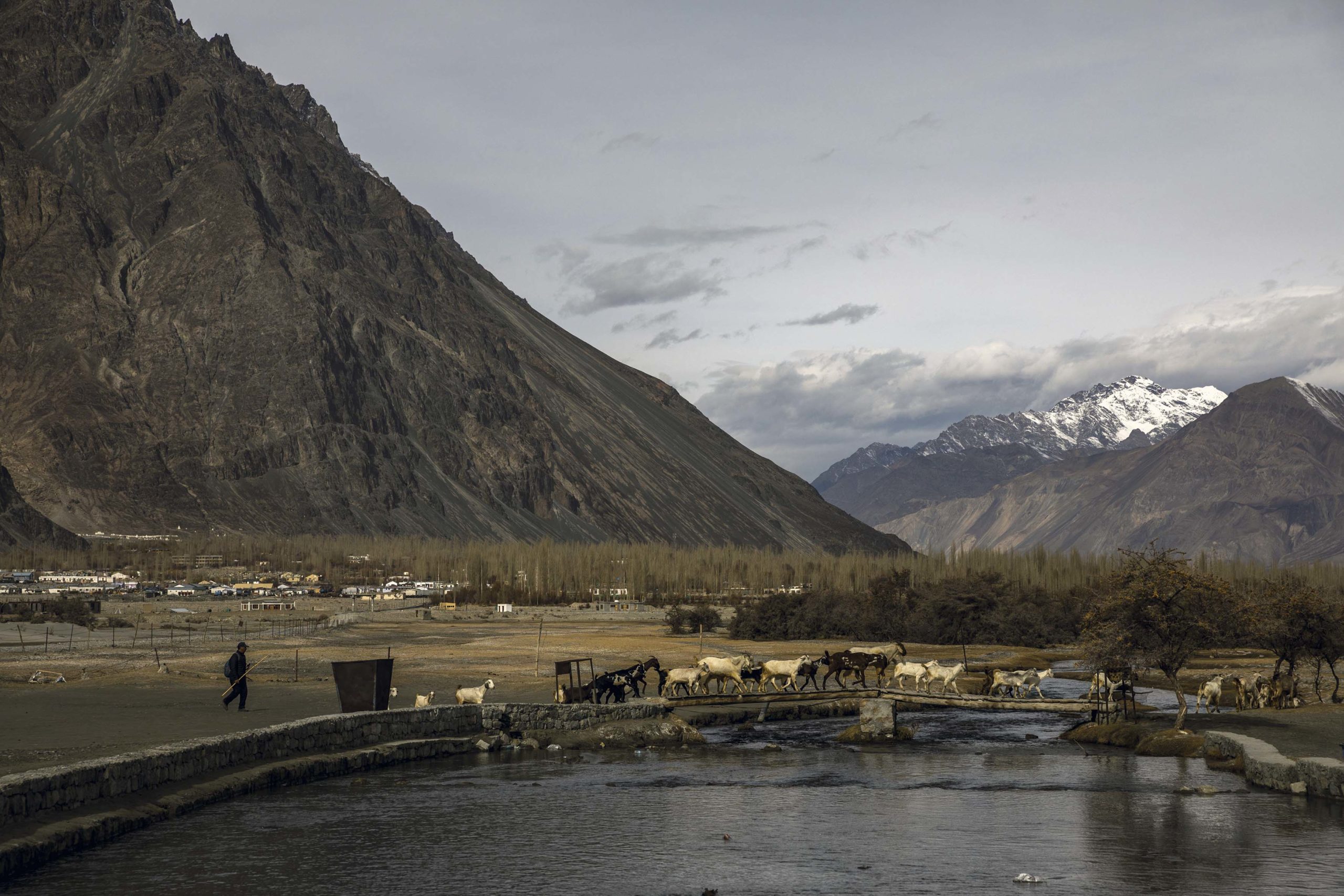The dangers of the disappearing glaciers
Low snowfall and rising temperatures brought on by climate change threaten the lives, agriculture and infrastructure of South Asians who rely on water sources in the Himalayas.
Author:
25 November 2021

Glaciers in the Himalayas that serve as water reservoirs to nearly two billion people in South Asia have altered dramatically in recent decades, threatening water supply and safety in the entire Indian subcontinent. Glaciers in the Kashmir Himalayas, especially, are melting at an alarming rate.
Scientists have discovered that glaciers in Kashmir’s north-western Himalayan region are disappearing at a faster rate than in other regions of the Himalayan arc. Using satellite data, fieldwork photographs and ground-based observations, a study published in September showed that Kashmir’s Machoi glacier has lost 29% of its size between 1972 and 2019.
The study’s researchers at Kashmir University noted that the retreating glaciers may have a significant effect on river flow patterns, hydropower generation and agricultural production in the region.
“Based on the comparison with earlier works carried out on neighbouring glaciers in the western Himalayan region, Machoi is the fourth highest retreating glacier losing area at 0.66% per year,” wrote the researchers.
Related article:
The Machoi glacier is located in the Dras region in north-west Kashmir, stretching between 3 762m and 5 050m above sea level. It is close to the Srinagar-Kargil Highway, exposing the glacier to traffic pollution and other emissions.
The study showed that Machoi is vulnerable to cryoconite holes. Cryoconite is a powder composed of rock particles, soot and microbes. When it lands on a glacier, the soot melts a portion of the ice, creating a hole in the glacier’s surface. Aerosols, unburned carbon particles and other debris collect in this hole over time and hasten melting. “Microbial life, which can survive in these environments, also releases heat that contributes to the melting,” the research stated.
The researchers found that Machoi is a moderately receding glacier whose recession rates fall between the rapidly melting Kashmir Himalayan glaciers and the slowly retreating Zanskar group of glaciers among land-terminating ice-masses.
These findings, while disturbing, are not surprising. Earlier research has also revealed that almost all glaciers in the Indus, which include Kashmir’s glaciers, are receding rapidly.
Shrinking giants
A 2020 study mapped 147 glaciers in the Kashmir region from 1980 to 2018, tracking the effects of topography, morphology and climate. According to the report, glaciers have shrunk by 28.82% during this period, and glacier loss in the region is considerably larger than in other Himalayan regions.
The Kolahoi glacier in Kashmir, the biggest glacier in the Himalayas, has lost almost 23% of its area and fractured into smaller sections since 1962. Several smaller adjacent glaciers were found to have disappeared. The Kolahoi glacier has shrunk to about 11.5 square kilometres from about 13 square kilometres in the past 40 years.
The meltwater from Kolahoi makes the Kashmir valley fertile for the production of cereal crops, fruit that is then dried, saffron and apples. Kolahoi feeds two major tributaries of the Jhelum River. The rapid recession of this major glacier directly threatens the livelihoods of millions of people living downstream.
Related article:
Outside of the Arctic and Antarctic, the extended Hindu Kush Himalayan region from north-east India to Afghanistan holds the largest concentration of snow and frozen water on Earth – its high mountain “water towers” hold so much ice, the area is called “the third pole”. Nearly 15 000 Himalayan glaciers, including 3 136 in the mountain belt of Jammu and Kashmir, make up a unique reservoir that feeds perennial rivers such as the Indus, Ganges, Brahmaputra and Mekong, supplying the drinking water and agricultural needs of large sections of the population living on the Indo-Gangetic plains.
Studies have concluded that the primary drivers of accelerated glacier retreat are an increase in temperature and a decline in snow precipitation. Research has shown that temperature rises in the Himalayan area have been between 0.15°C and 0.6°C per decade, which is much higher than the average rate of global warming.
Floods and landslides
The latest Intergovernmental Panel on Climate Change (IPCC) study, issued in August, warns that more changes are on the cards for the Himalayas. The analysis predicts that seasonal snow duration, glacial mass and permafrost area will continue to diminish by mid-century. Snow-covered areas and snow volumes will decrease in most sections of the Hindu Kush Himalayas, while glacier volumes will likely decline with greater mass loss under higher carbon dioxide emissions scenarios.
Low seasonal snow cover, the loss of summer Arctic sea ice as well as the melting of glaciers and ice sheets will be exacerbated by further rises in global temperature. The IPCC report projects that in the coming decades climate changes will increase in all regions. With a 1.5°C rise in global temperature, there will be increasing heat waves and longer warm seasons. With a 2°C rise, heat extremes would more often reach critical tolerance thresholds for agriculture and health, the report shows.
A 2019 report by the International Centre for Integrated Mountain Development has concluded that glaciers in the Hindu Kush Himalayan region could lose over a third of their volume by 2100, even if the world manages to keep global warming below 1.5°C. Since the 1970s, almost 15% of the ice has gone. In the short term, glaciers in the Himalayan area are projected to lose 10% to 30% of their mass by 2030. This number is predicted to rise to 25% to 35% by 2050.
Related article:
As the snow melts faster, the Himalayas are increasingly marked by lakes. According to one report, almost 900 new glacier-fed lakes emerged across Asia’s high mountain ranges between 1990 and 2010.
When glaciers melt, the water in glacial lakes accumulates behind loose, natural “glacial/moraine dams” made of ice, sand, pebbles and ice residue. As these mountain lakes fill up with additional snow melt and moraines can no longer hold, what scientists call a glacial lake outburst flood can arise. These sudden glacial floods pose a massive risk to downstream infrastructure and life.
In February this year, a part of the Nanda Devi glacier broke off in north India’s Uttarakhand state, flooding the Dhauliganga River and causing large-scale devastation in the upper reaches of the ecologically fragile Himalayas. Dozens of people were killed. In 2013, a similar flash flood caused by glacial lake outburst also in Uttarakhand killed at least 5 700 people and left unprecedented damage and destruction.
A 2008 United Nations-sponsored study, Mountains of Concrete: Dam Building in the Himalayas, predicted dramatic drops in inflows into the Indus basin in the next 100 years. The study warned of extreme changes in river flows because of global warming. “As glaciers melt, water in the rivers will rise and dams would be subjected to much higher flows, raising concerns about dam safety, increased flooding and submergence. And with the subsequent depletion of glaciers, there would be much lower annual flows, affecting the performance of dams built with huge investments,” the study noted.
Erratic water supply
The melting of glaciers and the associated effects interfere with the activities of people who rely on their waters. The South Asia region is already experiencing faster snow melt, higher winter temperatures and more severe rains, which generate frequent floods and landslides, soil erosion, and debris and silt accumulation. Crops are harmed, fruit ripens too soon, and agricultural insects and illnesses are becoming more widespread.
Those who rely on the enormous rivers that flow from the Himalayas into India, Pakistan, China and other countries will suffer immediate and dire consequences. The billions of people living downstream from the Himalayas will be affected by increasingly unreliable and erratic water supply. Less intense snowfalls, for example, have already delayed grass production in meadows, altering herd movements, particularly yak migration. Growing seasons are shorter than in the past, affecting harvests and the social life of farmers.
Related article:
According to a recent BBC report on a Kumik village in India’s northern Ladakh area, glacier shrinkage because of global warming has triggered a severe water shortage in the area, forcing some people to abandon their houses and migrate.
Another threat to glaciers is the overcrowding of ecologically sensitive areas as India, Pakistan and China, which share the Hindu Kush Himalayan ranges, continue to promote religious tourism, construction projects and military installations.




